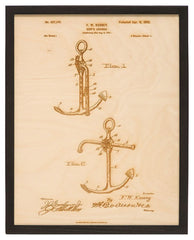If you are searching for a stunning addition to your nautical art collection, look no further than our paddle patent art. This intricate wood art of the paddle presents the original patent of the propelling kit in fine detail, etched precisely into Baltic birch.
Let’s take a look at the history and use of the paddle to further validate the fact that you need this gorgeous paddle patent art hanging on your very own wall in your home or office.
What Is a Paddle?

First things first, a “paddle” for watercraft is a typically wooden tool that has a long handle and a broad, flattened blade that is used to propel and steer small crafts such as canoes or kayaks. Canoes are propelled with a single-bladed paddle, and kayaks are propelled with a double-bladed paddle. Used for both survival and recreation, the paddle has offered people a means to control their water travel for generations.
History of Canoes, Kayaks, and Paddles
According to Encyclopedia Britannica, Christopher Columbus recorded the West Indian’s word, “canoa,” which was used to describe their boats. The earliest canoes were used by the Inuit of Alaska and the Algonquin peoples in what is now the northeastern United States and neighboring Canada. “Dugouts” — shaped and hollowed-out logs — were used by indigenous peoples in modern-day southeastern United States and along the Pacific Coast, as well as in Africa, New Zealand, and other areas in the Pacific.
For canoeists and kayakers of the past, a paddle was a valuable tool since the raw materials were difficult to find — such as driftwood, river logs, or gathered wood from forests. Then came the hard work of carving the handle, crafting the blades, and constructing the paddle. The length of the paddle was determined by the size of the watercraft and sitting position of the kayaker or canoeist.
The Filing of the Paddle Patent
Charles F. Kilgore of Minneapolis, Minnesota, filed the patent application for a boat-propelling kit on March 13, 1915, and it was granted on Dec. 14, 1915. His purpose was to provide a kit to propel watercraft. Our paddle patent art displays Kilgore’s original boat propelling kit in striking detail.
In his patent filing, Kilgore stated that the kit he described was “intended for use in propelling light watercraft, such as duck boats, row boats, canoes, rafts, and the like.” In addition, Kilgore said the paddle was intended to be stowed on motor or sailboats in case of emergency and for making landings. Our wood art displays the first page of Kilgore’s detailed illustration of the boat-propelling kit.
What Is a Patent and How Is One Filed?
A patent of an invention is “the grant of a property right to the inventor, issued by the United States Patent and Trademark Office,” according to the USPTO. The term of a new patent is typically 20 years from the date the patent application was filed. The patent grant confers “the right to exclude others from making, using, offering for sale, selling, or importing the invention.”
In order to apply for a patent with the USPTO, you must:
- Figure out what kind of intellectual property protection is needed
- Find out if the invention is actually patentable
- Learn what type of patent is needed
- Prepare to apply
- Submit the application
- Work with an examiner
- Receive approval
- Maintain the patent
Once you and your invention make it through this rigorous process, you’ll have your very own patent that you can hang on your wall alongside your wood art of Kilgore’s paddle patent.
Paddle Patent Art Is for Any Nautical Art Collector
If you’re a serious collector of nautical-themed art or simply have a few pieces of maritime artwork in your home, this wood art of the paddle would be a welcome addition to your walls in any room. The paddle patent art is laser-cut into pale, hand-stained Baltic birch and placed in a custom wood frame. Standing alone or in a collection of marine images, the light wood against the dark frame and the delicate detail of Kilgore’s illustration will surely make this piece stand out.
How to Style Paddle Patent Art
So now that you’re sold on adding this artwork to your collection, where do you hang it? This wood art would work well styled in virtually any room of your home or workplace.
Here are just a few ideas on where and how to display your brand-new paddle patent art:
- In a nautical-themed nursery
- Above the bed in a cozy bedroom
- In an eclectic living room gallery wall
- Behind the desk of a dark, moody office
- Above the tub in a bright, airy bathroom
Other Beautiful Wood Art Pieces to Add a Nautical Touch to Your Home or Office
If you want to further expand your maritime home décor collection beyond the paddle patent art, consider adding some of our other amazing wall art options, as well.
Our Favorite Nautical Wood Art:
- Canoe patent art
- Anchor patent art
- Wall clock
- 3D nautical wood map of the Midwest and Great Lakes
- Nautical cork maps
Or, expand your collection beyond wall art to a cribbage board or serving tray. You seriously can’t go wrong with these unique items — have fun learning a new game like cribbage, and imagine all the diverse, helpful ways you can use a serving tray!
Wood Art Can Make an Amazing Addition to Your Walls
By now, you’ve hopefully been convinced that you need to add our beautiful paddle patent art to your home or office wall. From the lightly stained Baltic birch to the laser-cut details that precisely display Charles F. Kilgore’s original boat propelling kit patent illustration from 1915, this artwork is sure to become your next favorite piece. We hope you’ll also consider some of our other stunning patent wood art as a stylish way to decorate your home.
If you want to hang something on your walls that is not only beautiful but also displays a bit of history in a whimsical way, our wood art of the paddle is just perfect for you. You may just learn something about the history of paddles, canoes, and kayaks or even be able to teach your friends something new because of your paddle patent art.




